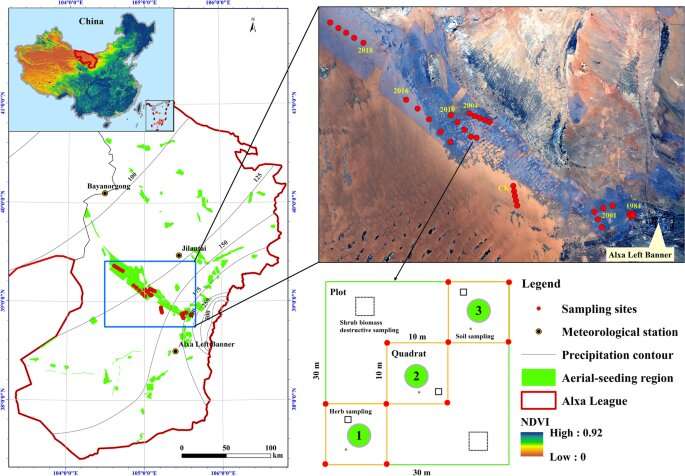This article has been reviewed according to Science X's editorial process and policies. Editors have highlighted the following attributes while ensuring the content's credibility:
fact-checked
trusted source
proofread
How afforestation by aerial sowing affects topsoil physicochemical properties in deserts

Large-scale afforestation in arid and semi-arid areas is one of the most effective approaches to combat desertification at present. Afforestation by aerial sowing is an effective measure that can promote vegetation restoration without subsequent artificial management, and can be widely employed in other ecosystems with similar vegetation degradation problems in the short term.
However, the effects of aerial sowing afforestation on soil physicochemical properties and their interactions are more complex and poorly understood.
Researchers from the Northwest Institute of Eco-Environment and Resources (NIEER) of the Chinese Academy of Sciences (CAS) have assessed the variation of topsoil physicochemical properties caused by aerial sowing afforestation in the sandy desert and quantified the relative contribution of soil texture and salinity to nutrients.
The study was published in Journal of Soils and Sediments on March 15.
The results showed that aerial sowing afforestation had coexisting positive and negative effects on soil physiochemical properties, with positive effects on soil texture improvement, soil total carbon (TC) and nutrients, weakly positive effects on the increase of total phosphorus (TP), and negative effects on available phosphorus (AP). The TC, TN, TP and AP in deserts exhibited a significant improvement in the first five years, and subsequently TC and TN stabilized, while TP decreased.
The researchers found that aerial sowing afforestation significantly increased the content of very fine sand, but not clay and silt. Although it could improve soil texture, carbon and nutrient accumulation was slower than tree planting.
Moreover, aerial sowing afforestation led to alkalization, which adversely affected the sustainability of the soil ecosystem, especially for soil microbe.
Soil texture and salinity had differentiated effects on soil nutrients. Variance partitioning analysis indicated that soil salinity and texture could account for 43.78% and 31.24% soil nutrients variation, respectively.
More information: Weiyu Chen et al, Effects of afforestation by aerial sowing on topsoil physicochemical properties in the sandy desert, NW China Journal of Soils Sediments (2023). DOI: 10.1007/s11368-023-03486-y. link.springer.com/article/10.1 … 7/s11368-023-03486-y
Provided by Chinese Academy of Sciences




















